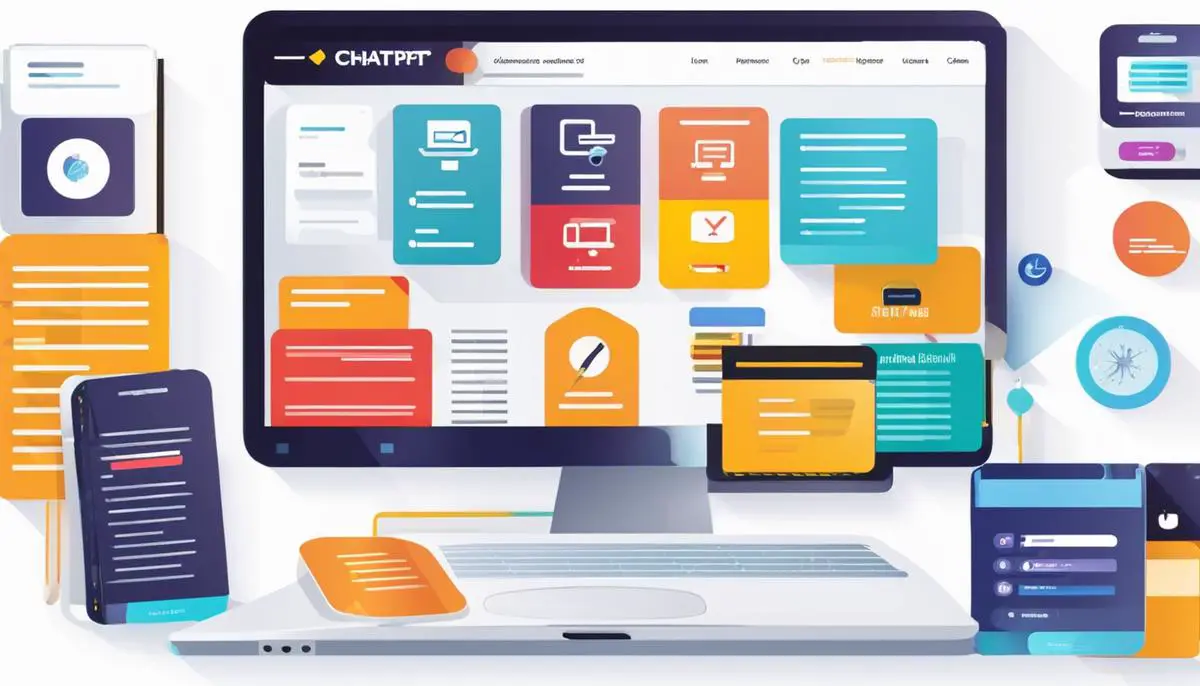The dawn of artificial intelligence has ushered in not just remarkable tools but revolutionary companions in the digital frontier. ChatGPT, a cutting-edge AI language model developed by OpenAI, exemplifies this evolution, offering capabilities that extend far beyond simple programmed responses. This essay delves into the essence of ChatGPT, demystifying the intricate technology that fuels its conversational prowess. As we wade through the myriad of applications, from coding assistance to customer service, you’ll learn not only what makes ChatGPT an exceptional tool but also how this digital marvel can be harnessed to exceed the limits of traditional interactions, creating outcomes that were once the stuff of science fiction.
Understanding ChatGPT
Unveiling ChatGPT: The AI Revolutionizing Conversations
In the ever-evolving realm of artificial intelligence, the latest marvel making waves is ChatGPT—a state-of-the-art language model developed by OpenAI. As technology enthusiasts, we’ve seen AI grow from its infancy to now engaging with us through sophisticated dialogue. ChatGPT stands at the pinnacle of this accomplishment, representing the cutting edge of what conversational AI can achieve. But what exactly is ChatGPT, and how does it function? Let’s dive in.
Fundamentals of ChatGPT
At its core, ChatGPT is a variant of the GPT (Generative Pretrained Transformer) architecture, which is designed to understand and generate human-like text. This language model leverages deep learning algorithms that are trained on a diverse range of internet text. With this training, ChatGPT can execute a myriad of language-based tasks—it can converse, answer questions, write essays, and much more with startling human-like proficiency.
ChatGPT’s Inner Workings
ChatGPT’s proficiency stems from how it functions internally. Let’s break down the technicalities:
Pre-Training
The model undergoes pre-training, which involves unsupervised learning on a large corpus of text data. This is where it learns linguistic patterns and the intricacies of human language—from syntax to semantics. It absorbs baseline knowledge that’s crucial for any language task.
Fine-Tuning
Post pre-training, the model is fine-tuned through supervised learning. This stage involves training the AI using datasets where the inputs and desired outputs are labeled. The model, thus, learns to predict the next word in a sentence with high accuracy, integrating context to maintain the dialogue or text flow.
Transformer Architecture
Central to ChatGPT’s capabilities is the transformer architecture—a neural network design that efficiently processes sequences of data. It uses ‘attention mechanisms’ that allow the model to weigh the importance of each word in a sentence when generating a response, leading to more coherent and contextually relevant outputs.
Large Parameters
ChatGPT is a large-scale model with millions of parameters. These are the aspects of the model that are learned from the training data and determine the model’s behavior. The vast number of parameters enables ChatGPT to capture complex language patterns, making its interactions impressively nuanced.
Engaging with ChatGPT
Using ChatGPT is seamless. Users can interact with it through various interfaces, from command-line tools to web platforms. Upon receiving a prompt or question, ChatGPT processes it, harnesses its deep neural network, and generates a response that it deems most appropriate based on its training.
Applications of ChatGPT
ChatGPT doesn’t just mimic conversation—it opens doors to streamlined workflows and enriched human-AI interactions. Its applications span customer service through AI-empowered chatbots, creative writing assistance, coding, education for language learning, and much more. The potential is expansive and only limited by the ingenuity of its adopters.
In Conclusion
ChatGPT stands at the frontier of conversational AI. Its sophisticated algorithmic foundations and exceptional ability to understand and generate text make it a pivotal tool in the tech enthusiast’s arsenal. Whether it’s automating customer support or generating creative content, ChatGPT is reshaping how we approach language-based tasks. The question isn’t if it will influence future technologies, but how swiftly we’ll integrate this AI dynamo into our digital ecosystems.

Interacting with ChatGPT
Effective Communication with ChatGPT: Strategies for Optimal Interaction
Navigating the communication landscape with ChatGPT involves clear and targeted input to yield the most accurate and useful responses. Here’s how to harness the full capacity of this tool:
- Articulate with Specificity: To extract the most value from ChatGPT, frame questions and prompts with high specificity. Ambiguous queries lead to broad answers that may lack utility. For instance, rather than asking “How do I code?,” one might ask “What are the best practices for exception handling in Python?”.
- Understand Context Limitations: While ChatGPT is adept at picking up on context within a conversation, its capability is not boundless. As a session progresses, be mindful of reminding or reintroducing context when necessary to maintain alignment with the intended topic.
- Utilize Keywords: Leveraging keywords that match the problem at hand helps ChatGPT align its responses appropriately. Keywords act as signposts, guiding the model’s focus and ensuring responses are relevant.
- Provide Examples: When seeking clarification or expansion of ideas, providing examples jumpstarts the model’s ability to produce more pertinent responses. Examples can ground the conversation and serve as a common reference point for further discussion.
- Sequence Questions Logically: Organize inquiries in a logical progression. If the ultimate goal is complex, start with foundational questions and escalate step-by-step. This allows ChatGPT to build upon previous answers, crafting responses that demonstrate a deeper understanding of the topic.
- Rephrase for Clarity: If the response from ChatGPT does not hit the mark, rephrase the question or provide more background information. Sometimes, a slight modification in the wording can be the key to unlocking a more fitting answer.
- Use Iterative Feedback: Feedback is a force multiplier with ChatGPT. Acknowledge the accuracy or relevance of responses to help the model calibrate subsequent outputs. A simple “This is helpful” or “I need more information on X” refines the interaction.
- Set Parameters: When applicable, delineate the scope or constraints of the task. Be explicit about parameters such as word count, style, or format to guide ChatGPT’s generation process.
- Employ Commands: For more technical or format-specific requests, direct commands are invaluable. “List,” “Explain,” “Summarize,” or “Convert” act as directives that initiate tailored actions from ChatGPT.
- Error Handling: Upon receiving an incorrect or unsatisfactory output, identify the mistake and correct it in the prompt. This teaches ChatGPT and avoids repetition of the error.
Interacting with ChatGPT effectively is akin to conducting an orchestra. It is precise, it requires an understanding of the instruments, and most critically, it demands a clear vision of the intended symphony. Approach every prompt as if fine-tuning a performance, and ChatGPT will deliver harmonious results that resonate with purpose and utility.

Applying ChatGPT Effectively
Diving deeper into real-world applications, ChatGPT stands as a versatile tool capable of transforming numerous industry practices, enhancing productivity, and redefining user interaction paradigms. Let’s break down additional, specific scenarios in which ChatGPT not only thrives but pushes the envelope of what conversational AI can do.
Personalizing E-commerce: In the bustling e-commerce sphere, personalization is king. ChatGPT, integrated with recommendation algorithms, can drive sophisticated, tailored shopping experiences. Picture this: a user chats about style preferences, and Bang! ChatGPT offers product suggestions that feel handpicked, increasing both satisfaction and the likelihood of conversion.
Mental Health Support: Leveraging its conversational prowess, ChatGPT can serve as a preliminary mental health support interface. Users can express concerns and receive immediate, non-judgmental responses. This is not a substitute for professional care but provides a bridge to resources and assists in destigmatizing mental health conversations.
Language Learning Platforms: Forget monotonous drills; ChatGPT revolutionizes language learning with interactive conversations in the target language. It corrects grammar, expands vocabulary, and even sharpens understanding of idioms and cultural nuances.
Intelligent To-Do Lists and Schedulers: By discussing plans and goals, users can task ChatGPT with organizing tasks or scheduling events. It interprets and synthesizes information presented in various formats and then updates calendars or task managers accordingly.
Legal and Compliance: In legal departments, ChatGPT can automate the initial drafting of standard legal documents or help navigate compliance checks by understanding the complex language of legislation and providing summaries or actionable items.
Content Moderation: Online communities can benefit immensely. ChatGPT can pre-screen content submissions for inappropriate material, reducing the load on human moderators and mitigating the spread of harmful content.
Accessibility: ChatGPT has the potential to break down barriers, serving as an assistive conversational agent for those with different types of disabilities. It can translate speech or text into more accessible formats, ensuring inclusivity in the digital realm.
Disaster Response Coordination: Situated within emergency management systems, ChatGPT can orchestrate communication by interpreting and relaying critical information between various response teams and the public during crisis scenarios, where precision and speed are non-negotiable.
The list is non-exhaustive, reflecting only a slice of ChatGPT’s expanding universe of applications. Each implementation rests on the robust backplane of AI-driven natural language processing, transforming and often automating interactions in ways previously relegated to science fiction. The march of progress does not halt, and with ChatGPT, spare the manual; automate, innovate, and streamline.

Embracing the potential of ChatGPT necessitates more than a cursory understanding; it demands an adeptness in communication, a strategic approach to prompt crafting, and a creative vision for implementation. This exploration has armed you with the requisite insights to transform these digital dialogues into productive exchanges. Armed with the knowledge of how to prompt effectively and the understanding of ChatGPT’s vast capabilities, you are now prepared to navigate this AI landscape with confidence, ready to leverage these insights to foster innovation, solve complex problems, and enhance the myriad domains that define our era’s digital tapestry.

